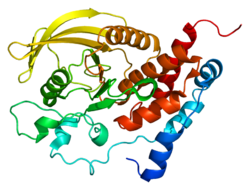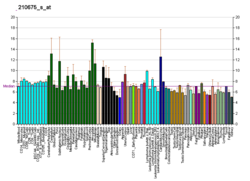PTPRR
PTPRR| PTPRR | |||||||||||||||||||||||||
|---|---|---|---|---|---|---|---|---|---|---|---|---|---|---|---|---|---|---|---|---|---|---|---|---|---|
 | |||||||||||||||||||||||||
| |||||||||||||||||||||||||
| 식별자 | |||||||||||||||||||||||||
| 에일리어스 | PTPRR, EC-PTP, PCPTP1, PTP-SL, PTPBR7, PTPRQ, 단백질티로신포스파타아제, 수용체형 R, 단백질티로신포스파타아제수용체형 R | ||||||||||||||||||||||||
| 외부 ID | OMIM : 602853 MGI : 109559 HomoloGene : 2135 GenCard : PTPRR | ||||||||||||||||||||||||
| |||||||||||||||||||||||||
| |||||||||||||||||||||||||
| |||||||||||||||||||||||||
| |||||||||||||||||||||||||
| 맞춤법 | |||||||||||||||||||||||||
| 종. | 인간 | 마우스 | |||||||||||||||||||||||
| 엔트레즈 | |||||||||||||||||||||||||
| 앙상블 | |||||||||||||||||||||||||
| 유니프로트 | |||||||||||||||||||||||||
| RefSeq(mRNA) |
| ||||||||||||||||||||||||
| RefSeq(단백질) |
| ||||||||||||||||||||||||
| 장소(UCSC) | Chr 12: 70.64 ~70.92 Mb | Chr 10: 115.85 ~116.11 Mb | |||||||||||||||||||||||
| PubMed 검색 | [3] | [4] | |||||||||||||||||||||||
| 위키데이터 | |||||||||||||||||||||||||
| |||||||||||||||||||||||||
단백질 티로신 포스파타아제 수용체 타입 R은 PTPRR [5][6][7]유전자에 의해 인체 내에서 암호화되는 효소이다.
기능.
이 유전자에 의해 암호화된 단백질은 단백질 티로신 포스파타아제(PTP) 계열의 구성원이다.PTP는 세포 성장, 분화, 유사분열 주기, 그리고 발암성 변형을 포함한 다양한 세포 과정을 조절하는 신호 분자로 알려져 있다.이 PTP는 세포외 영역, 단일 막간 영역 및 단일 세포내 촉매 도메인을 가지며, 따라서 수용체형 PTP를 나타낸다.마우스 뇌에서 주로 발현되는 유사한 유전자는 MAP 키나아제 활성과 세포 국재성을 조절하는 것으로 밝혀졌다.이 유전자의 쥐 부분은 신경 성장 인자에 의해 조절되는 것으로 보고되었으며, 이는 신경 성장과 [7]분화에서 이 유전자의 기능을 시사한다.
상호 작용
PTPRR은 MAPK7과 [8]상호작용하는 것으로 나타났다.
레퍼런스
- ^ a b c GRCh38: 앙상블 릴리즈 89: ENSG00000153233 - 앙상블, 2017년 5월
- ^ a b c GRCm38: 앙상블 릴리즈 89: ENSMUSG000020151 - 앙상블, 2017년 5월
- ^ "Human PubMed Reference:". National Center for Biotechnology Information, U.S. National Library of Medicine.
- ^ "Mouse PubMed Reference:". National Center for Biotechnology Information, U.S. National Library of Medicine.
- ^ Shiozuka K, Watanabe Y, Ikeda T, Hashimoto S, Kawashima H (Nov 1995). "Cloning and expression of PCPTP1 encoding protein tyrosine phosphatase". Gene. 162 (2): 279–84. doi:10.1016/0378-1119(95)00306-Q. PMID 7557444.
- ^ van den Maagdenberg AM, Schepens JT, Schepens MT, Merkx GF, Darroudi F, Wieringa B, Geurts van Kessel A, Hendriks WJ (Jul 1999). "Assignment1 of the PTP-SL/PTPBR7 gene (Ptprr/PTPRR) to mouse chromosome region 8A2 by in situ hybridization". Cytogenet Cell Genet. 84 (3–4): 243–4. doi:10.1159/000015268. PMID 10393441. S2CID 35964382.
- ^ a b "Entrez Gene: PTPRR protein tyrosine phosphatase, receptor type, R".
- ^ Buschbeck M, Eickhoff J, Sommer MN, Ullrich A (Aug 2002). "Phosphotyrosine-specific phosphatase PTP-SL regulates the ERK5 signaling pathway". J. Biol. Chem. 277 (33): 29503–9. doi:10.1074/jbc.M202149200. PMID 12042304.
추가 정보
- Sharma E, Lombroso PJ (1995). "A neuronal protein tyrosine phosphatase induced by nerve growth factor". J. Biol. Chem. 270 (1): 49–53. doi:10.1074/jbc.270.1.49. PMID 7814416.
- Ogata M, Sawada M, Fujino Y, Hamaoka T (1995). "cDNA cloning and characterization of a novel receptor-type protein tyrosine phosphatase expressed predominantly in the brain". J. Biol. Chem. 270 (5): 2337–43. doi:10.1074/jbc.270.5.2337. PMID 7836467.
- Pulido R, Zúñiga A, Ullrich A (1999). "PTP-SL and STEP protein tyrosine phosphatases regulate the activation of the extracellular signal-regulated kinases ERK1 and ERK2 by association through a kinase interaction motif". EMBO J. 17 (24): 7337–50. doi:10.1093/emboj/17.24.7337. PMC 1171079. PMID 9857190.
- Ogata M, Oh-hora M, Kosugi A, Hamaoka T (1999). "Inactivation of mitogen-activated protein kinases by a mammalian tyrosine-specific phosphatase, PTPBR7". Biochem. Biophys. Res. Commun. 256 (1): 52–6. doi:10.1006/bbrc.1999.0278. PMID 10066421.
- Zúñiga A, Torres J, Ubeda J, Pulido R (1999). "Interaction of mitogen-activated protein kinases with the kinase interaction motif of the tyrosine phosphatase PTP-SL provides substrate specificity and retains ERK2 in the cytoplasm". J. Biol. Chem. 274 (31): 21900–7. doi:10.1074/jbc.274.31.21900. PMID 10419510.
- Blanco-Aparicio C, Torres J, Pulido R (2000). "A novel regulatory mechanism of MAP kinases activation and nuclear translocation mediated by PKA and the PTP-SL tyrosine phosphatase". J. Cell Biol. 147 (6): 1129–36. doi:10.1083/jcb.147.6.1129. PMC 2168101. PMID 10601328.
- Augustine KA, Silbiger SM, Bucay N, Ulias L, Boynton A, Trebasky LD, Medlock ES (2000). "Protein tyrosine phosphatase (PC12, Br7,S1) family: expression characterization in the adult human and mouse". Anat. Rec. 258 (3): 221–34. doi:10.1002/(SICI)1097-0185(20000301)258:3<221::AID-AR1>3.0.CO;2-W. PMID 10705342.
- Bektas A, Hughes JN, Warram JH, Krolewski AS, Doria A (2001). "Type 2 diabetes locus on 12q15. Further mapping and mutation screening of two candidate genes". Diabetes. 50 (1): 204–8. doi:10.2337/diabetes.50.1.204. PMID 11147789.
- Szedlacsek SE, Aricescu AR, Fulga TA, Renault L, Scheidig AJ (2001). "Crystal structure of PTP-SL/PTPBR7 catalytic domain: implications for MAP kinase regulation". J. Mol. Biol. 311 (3): 557–68. doi:10.1006/jmbi.2001.4890. PMID 11493009.
- Buschbeck M, Eickhoff J, Sommer MN, Ullrich A (2002). "Phosphotyrosine-specific phosphatase PTP-SL regulates the ERK5 signaling pathway". J. Biol. Chem. 277 (33): 29503–9. doi:10.1074/jbc.M202149200. PMID 12042304.
- Shin BK, Wang H, Yim AM, Le Naour F, Brichory F, Jang JH, Zhao R, Puravs E, Tra J, Michael CW, Misek DE, Hanash SM (2003). "Global profiling of the cell surface proteome of cancer cells uncovers an abundance of proteins with chaperone function". J. Biol. Chem. 278 (9): 7607–16. doi:10.1074/jbc.M210455200. PMID 12493773.
- Tárrega C, Ríos P, Cejudo-Marín R, Blanco-Aparicio C, van den Berk L, Schepens J, Hendriks W, Tabernero L, Pulido R (2006). "ERK2 shows a restrictive and locally selective mechanism of recognition by its tyrosine phosphatase inactivators not shared by its activator MEK1". J. Biol. Chem. 280 (45): 37885–94. doi:10.1074/jbc.M504366200. PMID 16148006.
- Eswaran J, von Kries JP, Marsden B, Longman E, Debreczeni JE, Ugochukwu E, Turnbull A, Lee WH, Knapp S, Barr AJ (2006). "Crystal structures and inhibitor identification for PTPN5, PTPRR and PTPN7: a family of human MAPK-specific protein tyrosine phosphatases". Biochem. J. 395 (3): 483–91. doi:10.1042/BJ20051931. PMC 1462698. PMID 16441242.










